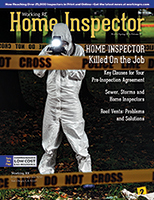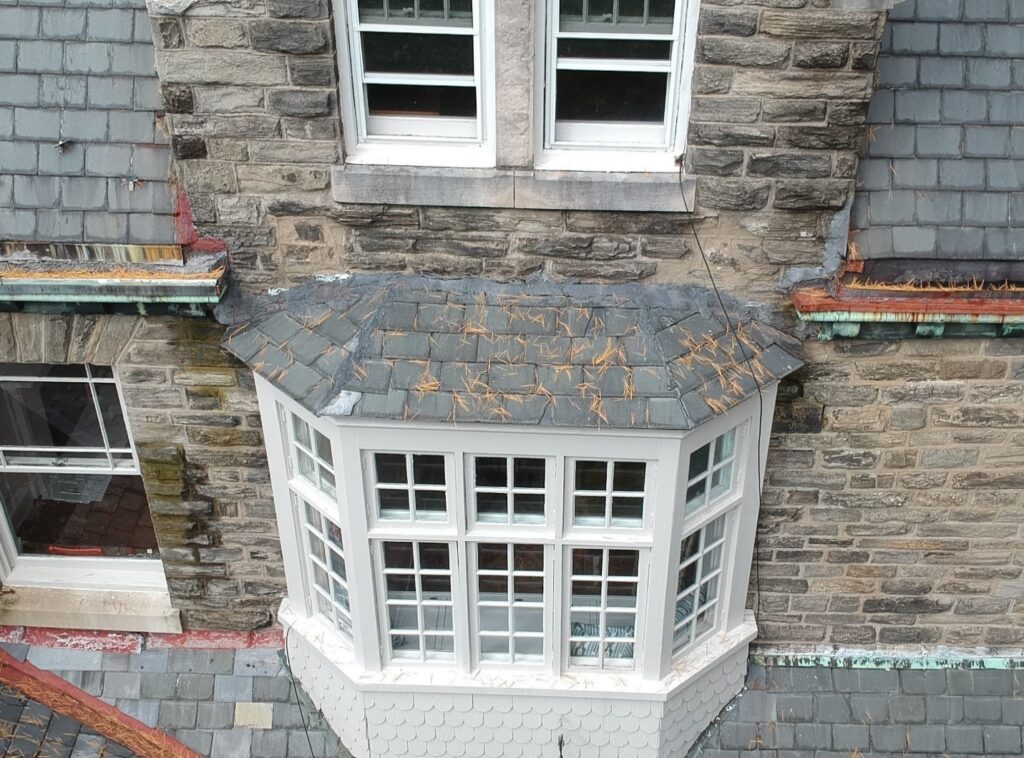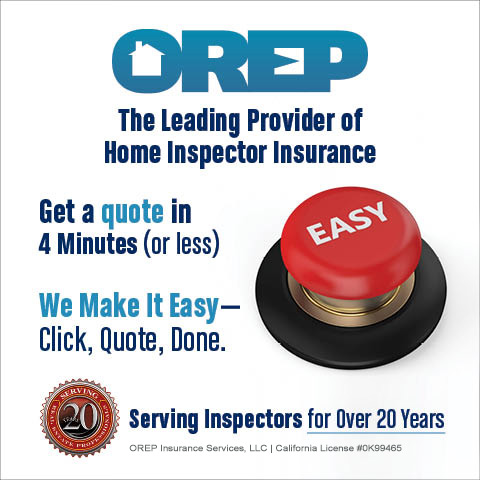 | > E&O/GL Insurance for Home Inspectors Competitive Rates, Broad Coverage, Free Risk Management, online inspection support for tough questions, discounts on education and more... Professional Coverage, Competitive Pricing Shop OREP today! |
>> Editor’s Note: To help you stay up-to-date and connected, OREP/Working RE has established a Coronavirus (COVID-19) Discussion and Resource Page where you can share your thoughts, experiences, advice and challenges with fellow inspectors. See what Inspectors are saying here!
“Drone inspections save time and reduce liability. While drone roof inspections cannot completely replace walking the roof when it is safe and appropriate, they are an important tool for an inspector to consider.”
Drones, Licensing, and Knowing Your Airspace
By Jon Stivers, Top Inspections LLC
It is becoming much more common for drones to be used for roof and exterior inspections. Drone images can provide a great overall picture of the roof. With a skilled pilot, it is also possible to get in close for detail shots. Drones are especially helpful if the roof is inaccessible due to height, steepness, roof covering material, or poor condition. Some inspectors use a drone for all roof inspections that do not have safe, permanent access. Drone inspections save time and reduce liability. While drone roof inspections cannot completely replace walking the roof when it is safe and appropriate, they are an important tool for an inspector to consider.
The photo below shows a drone photo of a roof and exterior (See Figure 1: Oblique angle drone photograph). The overhead point of view allows the inspector to evaluate many aspects of the roof and exterior in one shot, and get an impression of the overall condition of the outside of the building. For example, in this photo the metal gutters and flashing look worn and corroded, and show evidence of piecemeal repairs. Several slate shingles have been replaced. The bay roof peaks have received a last resort repair using roofing cement. The stone walls show evidence of chronic water management problems. By contrast, the bay windows and scalloped siding appear to be in very good condition.

The photo allows the inspector to conclude that the house roof and exterior has received some localized patching and repairs of various quality, but overall needs to be thoroughly renovated.
There are lots of drones on the market that home inspectors can choose from. Prosumer models feature cameras with resolutions comparable to a high-quality phone. Higher end models have larger photo sensors, zoom lenses, and can include infrared capability. There is plenty of information available for selecting a drone and learning to fly. Beyond that, it is important to fly legally and safely while doing inspections. The purpose of this article is to provide a simple introduction to legal and safe commercial drone operation.
Getting Your Pilot Certificate
The Federal Aviation Administration (FAA) requires commercial operators to fly by the rules of Part 107 for small unmanned aircraft systems. To summarize the rules as they apply to home inspection, a Part 107 drone “license” is required if compensation is received for use of the drone images. This includes images in a paid inspection report. For perspective on this federal law, note that posting drone footage on YouTube to promote a business is also considered commercial use. Suffice it to say that home inspectors will need a Part 107 Pilot’s Certificate.
The first step to getting a Part 107 certificate is to create a personal profile with the FAA. This can be done at https://iacra.faa.gov/IACRA/. The FAA calls this profile the Integrated Airman Certification and Rating Application. The purpose of the profile is to create a digital folder to contain any pilot ratings and aircraft registrations associated with the drone pilot. The FAA will run a background check as part of creating the profile. It is important to note that when the application is approved a unique FAA Tracking Number (FTN) will be assigned to the personal profile. This number will follow the pilot throughout his career. Be sure to write down this number. It will be needed when registering for the exam.
After getting signed up with the FAA, it is time to study for the Part 107 exam. As per the FAA, the exam topics include:
- Applicable regulations relating to small unmanned aircraft system rating privileges, limitations, and flight operation
- Airspace classification and operating requirements, and flight restrictions affecting small unmanned aircraft operation.
- Aviation weather sources and effects of weather on small unmanned aircraft performance
- Small unmanned aircraft loading and performance
- Emergency procedures
- Crew resource management
- Radio communication procedures
- Determining the performance of small unmanned aircraft
- Physiological effects of drugs and alcohol
- Aeronautical decision-making and judgment
- Airport operations
- Maintenance and preflight inspection procedures
- Operation at night
There are many companies that charge for Part 107 training classes, both in person and online. A typical class costs $150.00. Some people pass the test by watching free YouTube videos. Another good option is to get a review book. The author favors a book called, The Remote Pilot Test Prep 2021, by ASA Test Prep. The FAA publishes a book that is used in conjunction with the ASA book. It is called, FAA-CT-8080-2H Airman Knowledge Testing Supplement for Sport Pilot, Recreational Pilot, Remote Pilot, and Private Pilot.
The key to the ASA book approach is the quizzes at the end of each chapter and the online access to 5 free practice tests that are available with the purchase of the book. The questions and answers on the chapter quizzes and the online tests are very similar to the actual Part 107 exam. The aviation maps, charts and tables in the FAA Airman Knowledge Testing Supplement are nearly identical to those that appear on the real exam.
(story continues below)

When working through the ASA test prep book, make sure to understand and review all quiz questions that are missed, and the topics from which the questions are drawn. Make sure to understand all the quiz questions and answers before taking a practice exam. Then take one practice exam and review the missed questions in the same way as the quizzes. Keep reviewing and taking quizzes and then keep taking the exams until a solid passing score is achieved. Once you’re comfortable with the practice exams, it is time to take the real exam.
The test must be scheduled in advance and taken in person. The FAA provides a list of test centers. The fee is $175 for every test attempt. The exam is two hours long, and there are 60 questions. The test results appear in the student’s IACRA file about 48 hours after the exam.
Once the exam results are in the IACRA file, there is one more step to achieving the drone pilot certification. Within the IACRA profile, an application for the Part 107 certification must be submitted to the FAA. Even though the test has been passed, it is still necessary to apply for the certification. If that seems confusing, it is. Just remember the steps: Set up the IACRA profile.
Note the FTN number. Make sure to enter the same FTN number when signing up to take the Part 107 exam. The results of the exam will appear in the IACRA folder a few days later.
Use the exam results to make an application within the IACRA profile, for the Part 107 certification. Once that is completed, a temporary certificate is available online to print out. The permanent airman card showing the Part 107 certification will be mailed to you within a few weeks. Remember that proof of certification needs to be carried with you during all drone operations. By virtue of preparation for and passing the exam, the Part 107 certificate holder understands how to fly safely and legally. The following highlights and introduces some important points, but is by no means a complete explanation.
Rules for Flying
The basic limitations are that a drone must be operated during the day, always in a visual line of sight, and no higher than 400 feet above the ground. The limitations apply in uncontrolled as well as controlled airspace. In uncontrolled airspace, there is either no need for Air Traffic Control (ATC), or it is not practical. The Part 107 remote pilot is expected to fly by the rules anyway.
But in controlled airspace that is usually found around airports and densely populated areas, it is necessary for the part 107 pilot to request authorization from ATC.
Authorization may include additional limitations on altitude and other aspects of drone flight. There are many caveats to these rules. For example, uncontrolled airspace can be temporarily controlled or restricted due to a public event, such as a football game, or the presence of VIPs. The remote pilot finds out about these exceptions by reading the Notices to Airmen (NOTAMS) that are available online.
Inspectors that perform roof inspections in urban and suburban environments often find themselves in controlled airspace. One look at an aviation chart will show how complicated navigating in controlled airspace can be (See Figure 2: Aviation Sectional of Southern Los Angeles, CA). Since the drone pilot is flying in a very localized area and at an altitude safely below manned aircraft, things are a little simpler.


To make things easier for commercial drone pilots, the FAA has partnered with some online sites that provide ATC authorization in near real-time. The system is called the Low Altitude Authorization and Notification Capability (LAANC). Airmap.com and KittyHawk.io are two websites that will display ATC authorization in real-time. Applying for authorization is almost as simple as placing a pin on a digital map. For each flight, the pilot logs the location, date, and time of the desired flight, the drone that will be used, the altitude and the duration of the flight. Figure 3 shows a screenshot from Airmap.com. Outside the blue circle is uncontrolled air space. The red dots indicate restricted airspace. (See Figure 3: Grid from Airmap.com showing maximum altitude).
Under normal circumstances, the authorization from ATC will come back in a few minutes. Authorization comes with some notes about the flight, relevant Notices to Airmen (NOTAMS), and a brief weather report for the time and location of the flight. It is a good idea to book the flight at least the day before in case there is an issue. For example, if the inspection site is very close to an airport or in a restricted area, the allowed altitude may be reduced to 0. It is good to know that sooner than a few hours before the inspection.
Hopefully this article has presented a useful introduction to getting a Part 107 license and flying in a controlled airspace. There is a lot more to learn about safe commercial drone flying. The first step is to get an FAA IACRA profile set up. The next is to study for and pass the Part 107 exam. Then, use the results of the Part 107 exam to apply for certification within the IACRA profile. Finally, use LAANC for rapid ATC flight authorization.
About the Author
Jon Stivers is the owner of Top Inspections, LLC located in Philadelphia, Pennsylvania. Stivers is a certified INTER-NACHI inspector and general contractor, and holds a Part 107 remote pilot certificate. Stivers usually flies a DJI Mavic Air 2 and his website is TopInspectionsLLC.com. If the reader has questions related to this article, email Jon at jons@topinspectionsllc.com.
OREP/WRE Coronavirus Discussion and Resource Page
Coronavirus: National Home Inspector Survey
Real-Life Inspector Lawsuits and How to Protect Yourself
Available Now
Presenter: Isaac Peck, President of OREP
Isaac Peck, President of OREP Insurance Services, shares his insights and advice gained over nearly 10 years of providing risk management and E&O insurance for home inspectors. You will not hear many of these insights anywhere else.
Watch Now!
Send your story submission/idea to the Editor:
isaac@orep.org
Note: The Winter/Spring 2022 Working RE Home Inspector is now mailing to over 25,000 home inspectors nationwide. OREP Insureds/members enjoy guaranteed delivery of each print magazine and many more benefits.



by Victor G. Faggella, P.E.
One thing that’s isn’t clear is that it doesn’t matter if you charge for the service. If it’s part or any commercial venture-anything other than recreational flying-you need a part 107 sUAS AIRMEN CERTIFICATE.
-